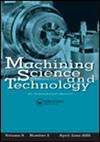基于微观结构演化的铬镍铁合金718微端铣削力模型及表面特性研究
IF 2.6
4区 工程技术
Q2 ENGINEERING, MANUFACTURING
引用次数: 1
摘要
摘要切削力的准确预测对切削工件的表面质量和刀具磨损起着至关重要的作用。在微铣削中,加工的特征尺寸和进给/齿与材料晶粒尺寸和立铣刀的边缘半径相当。因此,需要解决结垢问题、材料微观结构和切削温度对加工性能的影响。建立了考虑尺寸效应、加工温度、工件回弹效应和微观组织演变的微立铣削力模型。用Inconel 718的实验结果验证了所建立的力模型,预测误差小于10%。通过实验研究了尺寸效应对Inconel 718微铣削切削力、显微硬度和表面缺陷的影响。最小未切割切屑厚度在0.9µm附近。当进给/齿小于0.9µm时,切削力和端面显微硬度均呈非线性趋势。在进给/齿小于0.9µm时,由于高应变硬化和显著的犁削效应,切削力值较高。本文章由计算机程序翻译,如有差异,请以英文原文为准。
Micro-structure evolution-based force model and surface characteristic studies of Inconel 718 during micro-endmilling
Abstract An accurate prediction of cutting force is significant, as it plays a critical role on surface quality and tool wear. In micro-endmilling, the machined feature size and feed/tooth are comparable to the material grain size and the edge radius of the endmill. Hence, the effects of scaling issues, material micro-structure and cutting temperature on the machining performance need to be addressed. This article presents a force model for micro-endmilling by incorporating size effect, machining temperature, workpiece spring back effect and micro-structure evolution. The developed force model was validated with experimental results on Inconel 718 and the prediction error was found to be less than 10%. An experimental study to understand the influence of size effect on cutting force, micro-hardness and surface defect during micro-endmilling on Inconel 718 was carried out. Minimum uncut chip thickness was observed adjacent to 0.9 µm. For a feed/tooth less than 0.9 µm, both cutting force and micro-hardness of the endmilled surface shows a nonlinear trend. Higher value of cutting force at feed/tooth less than 0.9 µm was observed due to high strain hardening, and significant plowing effect on the micro-endmilled surfaces.
求助全文
通过发布文献求助,成功后即可免费获取论文全文。
去求助
来源期刊

Machining Science and Technology
工程技术-材料科学:综合
CiteScore
5.70
自引率
3.70%
发文量
18
审稿时长
6 months
期刊介绍:
Machining Science and Technology publishes original scientific and technical papers and review articles on topics related to traditional and nontraditional machining processes performed on all materials—metals and advanced alloys, polymers, ceramics, composites, and biomaterials.
Topics covered include:
-machining performance of all materials, including lightweight materials-
coated and special cutting tools: design and machining performance evaluation-
predictive models for machining performance and optimization, including machining dynamics-
measurement and analysis of machined surfaces-
sustainable machining: dry, near-dry, or Minimum Quantity Lubrication (MQL) and cryogenic machining processes
precision and micro/nano machining-
design and implementation of in-process sensors for monitoring and control of machining performance-
surface integrity in machining processes, including detection and characterization of machining damage-
new and advanced abrasive machining processes: design and performance analysis-
cutting fluids and special coolants/lubricants-
nontraditional and hybrid machining processes, including EDM, ECM, laser and plasma-assisted machining, waterjet and abrasive waterjet machining
 求助内容:
求助内容: 应助结果提醒方式:
应助结果提醒方式:


